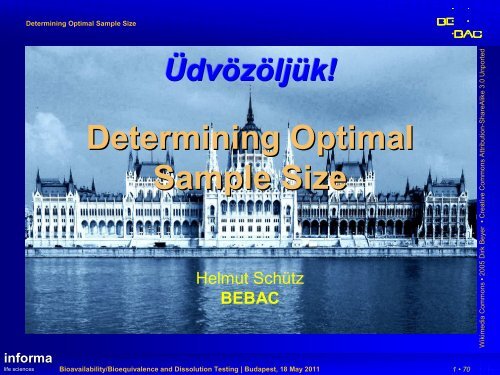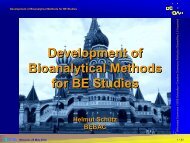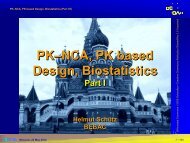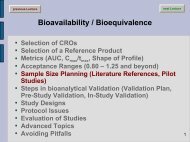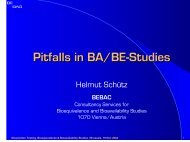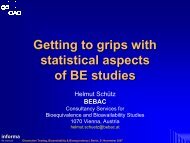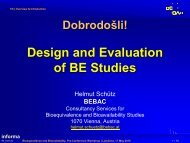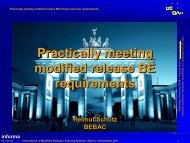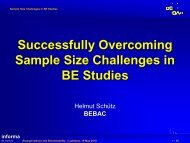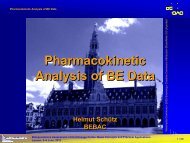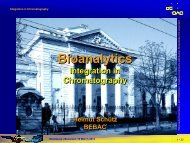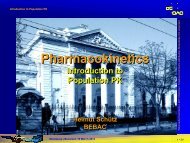Determining Optimal Sample Size - BEBAC ⢠Consultancy Services ...
Determining Optimal Sample Size - BEBAC ⢠Consultancy Services ...
Determining Optimal Sample Size - BEBAC ⢠Consultancy Services ...
- No tags were found...
Create successful ePaper yourself
Turn your PDF publications into a flip-book with our unique Google optimized e-Paper software.
<strong>Determining</strong> <strong>Optimal</strong> <strong>Sample</strong> <strong>Size</strong>informalife sciencesÜdvözöljük!<strong>Determining</strong> <strong>Optimal</strong><strong>Sample</strong> <strong>Size</strong>Helmut Schütz<strong>BEBAC</strong>Bioavailability/Bioequivalence and Dissolution Testing | Budapest, , 181May 20111 • 70Wikimedia Commons • 2005 Dirk Beyer • Creative Commons Attribution-ShareAlike3.0 Unported
<strong>Determining</strong> <strong>Optimal</strong> <strong>Sample</strong> <strong>Size</strong>Minimum<strong>Sample</strong> <strong>Size</strong> (Limits)12: WHO, EU, CAN, NZ, AUS, AR, MZ, ASEAN States,RSA12: USA ‘A pilot study that documents BE can beappropriate, provided its design and execution aresuitable and a sufficient number of subjects (e.g.,12) have completed the study.’20: RSA (MR formulations)24: Saudia Arabia (12 to 24 if statistically justifiable)24: BrazilSufficient number: JPNinformalife sciencesBioavailability/Bioequivalence and Dissolution Testing | Budapest, , 181May 20112 • 70
<strong>Determining</strong> <strong>Optimal</strong> <strong>Sample</strong> <strong>Size</strong><strong>Sample</strong> <strong>Size</strong> (Limits)MaximumNZ: ‘If the calculated number of subjects appears to behigher than is ethically justifiable, it may benecessary to accept a statistical power which isless than desirable. Normally it is not practical touse more than about 40 subjects in a bioavailabilitystudy.’All others: Not specified (judged by IEC/IRB or localAuthorities).ICH E9, Section 3.5 applies: ‘The number ofsubjects in a clinical trial should always be largeenough to provide a reliable answer to thequestions addressed.’informalife sciencesBioavailability/Bioequivalence and Dissolution Testing | Budapest, , 181May 20113 • 70
<strong>Determining</strong> <strong>Optimal</strong> <strong>Sample</strong> <strong>Size</strong>Reminder<strong>Sample</strong> <strong>Size</strong> (Limits?) Generally power is set to at least 80 % (β, error type II:producers’s risk to get no approval for a bioequivalentformulation; power = 1 – β).1 out of 5 studies will fail just by chance! If you plan for power of less than 70 %, problems with theethics committee are likely (ICH E9). If you plan for power of more than 90 % (especially withlow variability drugs), problems with the regulator arepossible (‘forced bioequivalence’). Add subjects (‘alternates’) according to the expecteddrop-out rate – especially for studies with more than twoperiods or multiple-dose studies.informalife sciencesBioavailability/Bioequivalence and Dissolution Testing | Budapest, , 181May 20114 • 70
<strong>Determining</strong> <strong>Optimal</strong> <strong>Sample</strong> <strong>Size</strong>EUinformalife sciencesCV intraNfG on the Investigation of BA/BE (2001)The number of subjects required is determined by the error variance associated with the primarycharacteristic to be studied as estimated from a pilot experiment, previous studies, or published data, the significance level desired, the expected deviation (∆) from the reference productcompatible with BE and, the required power.1–βBioavailability/Bioequivalence and Dissolution Testing | Budapest, , 181May 2011α5 • 70
<strong>Determining</strong> <strong>Optimal</strong> <strong>Sample</strong> <strong>Size</strong>EUNfG on the Investigation of BA/BE (2001)Problems/solutions… the error variance associated with theprimary characteristic to be studied … Since BE must be shown both for AUC and C max , and, if you plan your sample size only for the ‘primary characteristic’(e.g., AUC), in many cases you will fail for thesecondary parameter (e.g., C max ), which most likely showshigher variability – your study will be ‘underpowered’. Based on the assumption, that CV is identical for test andreference (what if only the reference formulation has highvariability, e.g., some formulations of PPIs?).informalife sciencesBioavailability/Bioequivalence and Dissolution Testing | Budapest, , 181May 20116 • 70
<strong>Determining</strong> <strong>Optimal</strong> <strong>Sample</strong> <strong>Size</strong>EUNfG on the Investigation of BA/BE (2001)Problems/solutions … as estimated from a pilot experiment, previous studies, or published data, The correct order should read:1. previous studies → 2. pilot study → 3. published data Only in the first case you ‘know’ all constraints resultingin variability Pilot studies are often too small to get reliable estimatesof variability Advisable only if you have data from a couple of studiesinformalife sciencesBioavailability/Bioequivalence and Dissolution Testing | Budapest, , 181May 20117 • 70
<strong>Determining</strong> <strong>Optimal</strong> <strong>Sample</strong> <strong>Size</strong>EUNfG on the Investigation of BA/BE (2001)Problems/solutions … the significance level desired … Throughout the NfG the significance level(α, error type I: patient’s risk to be treated with abioinequivalent drug) is fixed to 5% (correspondingto a 90% confidence interval) You may desire a higher significance level, but sucha procedure is not considered acceptable In special cases (e.g., dose proportionality testing),a correction for multiplicity may be necessary In some legislations (e.g., Brazil’s ANVISA), α must betightened to 2.5% for NTIDs (95% confidence interval)informalife sciencesBioavailability/Bioequivalence and Dissolution Testing | Budapest, , 181May 20118 • 70
<strong>Determining</strong> <strong>Optimal</strong> <strong>Sample</strong> <strong>Size</strong>EUinformalife sciencesNfG on the Investigation of BA/BE (2001)Problems/solutions … the required power. Generally the power is set to at least 80 % (β, errortype II: producers’s risk to get no approval for abioequivalent drug; power = 1 – β).Remember: 1 out of 5 studies will fail just by chance! If you plan for power of less than 70 %, problems withthe ethics committee are likely (ICH E9). If you plan for power of more than 90 % (especially withlow variability drugs), problems with the regulator arepossible (‘forced bioequivalence’). Add subjects (‘alternates’) according to the expecteddrop-out rate!Bioavailability/Bioequivalence and Dissolution Testing | Budapest, , 181May 20119 • 70
<strong>Determining</strong> <strong>Optimal</strong> <strong>Sample</strong> <strong>Size</strong>Coefficient(s) of VariationCVs of higher design levels not available.If only mean±SD of reference available… Avoid ‘rule of thumb’ CV intra =60% of CV total Don’t plan a cross-over based on CV total Examples (cross-over studies)drug, formulationmethylphenidate MRdesignSDn12metricAUC t7.00CV inter19.1CV total20.4% intra/total34.3CV intra25.1paroxetine MRMD32AUC τ25.255.162.140.6lansoprazole DRSD47C max47.054.686.0 … pilot study unavoidableinformalife sciencesBioavailability/Bioequivalence and Dissolution Testing | Budapest, , 181May 201115 • 70
<strong>Determining</strong> <strong>Optimal</strong> <strong>Sample</strong> <strong>Size</strong>Literature DataLiterature search for CV%Preferably other BE studies (the bigger, the better!)PK interaction studies (Cave: mainly in steadystate! Generally lower CV than after SD)Food studies (CV higher/lower than fasted!)If CV intra is not given (quite often), a little algebrahelps. All you need is the 90% geometricconfidence interval and the sample size.informalife sciencesBioavailability/Bioequivalence and Dissolution Testing | Budapest, , 181May 201116 • 70
<strong>Determining</strong> <strong>Optimal</strong> <strong>Sample</strong> <strong>Size</strong>Literature Data12108frequency642total0101520CVs2530100 mg200 mgstudiesinformalife sciencesDoxicycline (37 studies from Blume/Mutschler, Bioäquivalenz: Qualitätsbewertung wirkstoffgleicherFertigarzneimittel, GOVI-Verlag, Frankfurt am Main/Eschborn, 1989-1996)Bioavailability/Bioequivalence and Dissolution Testing | Budapest, , 181May 201117 • 70
<strong>Determining</strong> <strong>Optimal</strong> <strong>Sample</strong> <strong>Size</strong>Algebra…informalife sciencesCalculation of CV intra from CI Point estimate (PE) from the Confidence LimitsPE = CL ⋅CL Estimate the number of subjects / sequence (example2×2 cross-over) If total sample size (N) is an even number, assume (!)n 1= n 2= ½N If N is an odd number, assume (!)n 1= ½N + ½, n 2= ½N – ½ (not n 1= n 2= ½N!) Difference between one CL and the PE in log-scale; usethe CL which is given with more significant digits∆ = ln PE − ln CL or ∆ = ln CL − ln PECL lo CL hiBioavailability/Bioequivalence and Dissolution Testing | Budapest, , 181May 2011lohi18 • 70
<strong>Determining</strong> <strong>Optimal</strong> <strong>Sample</strong> <strong>Size</strong>Algebra…Calculation of CV intra from CI (cont’d) Calculate the Mean Square Error (MSE)MSE⎛⎞⎜⎟⎜ ∆CL⎟= 2 ⎜ ⎟⎜ ⎛ 1 1 ⎞+ ⋅t⎟1−2 ⋅ α , n1 + n2−2⎜ ⎜n1 n⎟ ⎟⎝ ⎝ 2 ⎠ ⎠CV intrafrom MSE as usual% 100 MSECV1intra= ⋅ e −2informalife sciencesBioavailability/Bioequivalence and Dissolution Testing | Budapest, , 181May 201119 • 70
<strong>Determining</strong> <strong>Optimal</strong> <strong>Sample</strong> <strong>Size</strong>Algebra…Calculation of CV intra from CI (cont’d) Example: 90% CI [0.91 – 1.15], N 21 (n 1 = 11, n 2 = 10)PE = 0.91⋅ 1.15 = 1.023∆ = ln1.15 − ln1.023 = 0.11702CLMSECV⎛⎞⎜⎟0.11702= 2⎜⎟ = 0.04798⎜ ⎛ 1 1 ⎞ ⎟⎜ ⎜ + ⎟ × 1.729 ⎟⎝ ⎝11 10 ⎠ ⎠0.04798intra% = 100 × e − 1 = 22.2%2informalife sciencesBioavailability/Bioequivalence and Dissolution Testing | Budapest, , 181May 201120 • 70
<strong>Determining</strong> <strong>Optimal</strong> <strong>Sample</strong> <strong>Size</strong>Algebra…Proof: CI from calculated values Example: 90% CI [0.91 – 1.15], N 21 (n 1 = 11, n 2 = 10)ln PE = ln CL ⋅ CL = ln 0.91× 1.15 = 0.02274SE∆lohi2 ⋅ MSE 2 × 0.04798= = = 0.067598N 21CI = e ∆ = eCICIln PE± t⋅ SE 0.02274± 1.729×0.0675980.02274− 1.729×0.067598lo= e= 0.910.02274+ 1.729×0.067598hi= e= 1.15informalife sciencesBioavailability/Bioequivalence and Dissolution Testing | Budapest, , 181May 201121 • 70
<strong>Determining</strong> <strong>Optimal</strong> <strong>Sample</strong> <strong>Size</strong>Sensitivity to ImbalanceIf the study was more imbalanced thanassumed, the estimated CV is conservative Example: 90% CI [0.89 – 1.15], N 24 (n 1 = 16, n 2 = 8, butnot reported as such); CV 24.74% in the studyBalanced Sequencesassumed…n 112n 212CV%26.29131126.20141025.91Sequencesin study15169825.4324.74informalife sciencesBioavailability/Bioequivalence and Dissolution Testing | Budapest, , 181May 201122 • 70
<strong>Determining</strong> <strong>Optimal</strong> <strong>Sample</strong> <strong>Size</strong>No Algebra…Implemented in R-package PowerTOST,function CVfromCI (not only 2×2 cross-over,but also parallel groups, higher order crossovers,replicate designs). Previous example:require(PowerTost)CVfromCI(lower=0.91, upper=1.15, n=21, design = "2x2", alpha = 0.05)[1] 0.2219886informalife sciencesBioavailability/Bioequivalence and Dissolution Testing | Budapest, , 181May 201123 • 70
<strong>Determining</strong> <strong>Optimal</strong> <strong>Sample</strong> <strong>Size</strong>Pooling of CV%Intra-subject CV from different studies can bepooled (LA Gould 1995, Patterson and Jones 2006)In the parametric model of log-transformed data,additivity of variances (not of CVs!) apply.Do not use the arithmetic mean (or the geometricmean either) of CVs.Before pooling variances must be weightedacccording to the studies’ sample size – largerstudies are more influentual than smaller ones.informalife sciencesBioavailability/Bioequivalence and Dissolution Testing | Budapest, , 181May 201124 • 70
<strong>Determining</strong> <strong>Optimal</strong> <strong>Sample</strong> <strong>Size</strong>Pooling of CV%Intra-subject CV from different studiesCalculate the variance from CV2 2σW= ln( CVintra+ 1)Calculate the total variance weighted by df∑σ 2df WCalculate the pooled CV from total variance2CV e σ Wdf df=∑ ∑−1Optionally calculate an upper (1–α) % confidencelimit on the pooled CV (recommended α = 0.25)CLCV∑ σ χ ∑2 2Wdfα , df1= e −informalife sciencesBioavailability/Bioequivalence and Dissolution Testing | Budapest, , 181May 201125 • 70
<strong>Determining</strong> <strong>Optimal</strong> <strong>Sample</strong> <strong>Size</strong>Pooling of CV%Example 1: n 1 =n 2 ;CV Study1 < CV Study2studies N df (total) α 1–α total CV pooled CV mean2 24 20 0.25 0.75 1.2540 0.254 0.245χ ² (α ,df) 15.452 0.291 +14.3%CV intra n seq. df (mj) σ W σ ² W σ ² W × dfCV intra /pooled>CL upper0.200 12 2 10 0.198 0.0392 0.3922 78.6% no0.300 12 2 10 0.294 0.0862 0.8618 117.9% yesinformalife sciencesBioavailability/Bioequivalence and Dissolution Testing | Budapest, , 181May 201126 • 70
<strong>Determining</strong> <strong>Optimal</strong> <strong>Sample</strong> <strong>Size</strong>Pooling of CV%Example 2: n 1 CL upper0.200 12 2 10 0.198 0.0392 0.3922 73.5% no0.300 24 2 22 0.294 0.0862 1.8959 110.2% noinformalife sciencesBioavailability/Bioequivalence and Dissolution Testing | Budapest, , 181May 201127 • 70
<strong>Determining</strong> <strong>Optimal</strong> <strong>Sample</strong> <strong>Size</strong>Pooling of CV%Example 3: n 1 >n 2 ;CV Study1 < CV Study2studies N df (total) α 1–α total CV pooled CV mean2 36 32 0.25 0.75 1.7246 0.235 0.245χ ² (α ,df) 26.304 0.260 +10.6%CV intra n seq. df (mj) σ W σ ² W σ ² W × dfCV intra /pooled>CL upper0.200 24 2 22 0.198 0.0392 0.8629 85.0% no0.300 12 2 10 0.294 0.0862 0.8618 127.5% yesinformalife sciencesBioavailability/Bioequivalence and Dissolution Testing | Budapest, , 181May 201128 • 70
<strong>Determining</strong> <strong>Optimal</strong> <strong>Sample</strong> <strong>Size</strong>Pooling of CV%R package PowerTost function CVpooled,data of last example.require(PowerTOST)CVs
<strong>Determining</strong> <strong>Optimal</strong> <strong>Sample</strong> <strong>Size</strong>Pooling of CV%Or you may combine pooling with an estimatedsample size based on uncertain CVs (we willsee later what that means).R package PowerTost function expsampleN.TOST,data of last example.CVs and degrees of freedom must be given asvectors:CV = c(0.2,0.3), dfCV = c(22,10)informalife sciencesBioavailability/Bioequivalence and Dissolution Testing | Budapest, , 181May 201130 • 70
<strong>Determining</strong> <strong>Optimal</strong> <strong>Sample</strong> <strong>Size</strong>Pooling of CV%require(PowerTOST)expsampleN.TOST(alpha=0.05,targetpower=0.8,theta1=0.8, theta2=1.25,theta0=0.95, CV=c(0.2,0.3),dfCV=c(22,10), alpha2=0.05,design="2x2", print=TRUE,details=TRUE)++++++++ Equivalence test - TOST ++++++++<strong>Sample</strong> size est. with uncertain CV-----------------------------------------Study design: 2x2 crossoverDesign characteristics:df = n-2, design const. = 2, step = 2log-transformed data (multiplicative model)alpha = 0.05, target power = 0.8BE margins = 0.8 ... 1.25Null (true) ratio = 0.95Variability dataCV df0.2 220.3 10CV(pooled) = 0.2353158 with 32 dfone-sided upper CL = 0.2995364 (level = 95%)informalife sciences<strong>Sample</strong> size searchn exp. power24 0.76658526 0.800334Bioavailability/Bioequivalence and Dissolution Testing | Budapest, , 181May 201131 • 70
<strong>Determining</strong> <strong>Optimal</strong> <strong>Sample</strong> <strong>Size</strong>Power CurvesPower to show2×2 Cross-overBE with 12 – 36subjects forCV intra = 20%n 24 → 16:power 0.896→ 0.735Power10.90.80.70.60.50.40.30.23624161220% CVinformalife sciencesµ T /µ R 1.05 → 1.10:power 0.903→ 0.700Bioavailability/Bioequivalence and Dissolution Testing | Budapest, , 181May 20110.100.8 0.85 0.9 0.95 1 1.05 1.1 1.15 1.2 1.25µT/µR32 • 70
<strong>Determining</strong> <strong>Optimal</strong> <strong>Sample</strong> <strong>Size</strong>Power vs. <strong>Sample</strong> <strong>Size</strong>informalife sciencesIt is not possible to directly calculate therequired sample size.Power is calculated instead, and the lowestsample size which fulfills the minimum targetpower is used.Example: α 0.05, target power 80%(β 0.2), T/R 0.95, CV intra 20% →minimum sample size 19 (power 81%),rounded up to the next even number ina 2×2 study (power 83%).Bioavailability/Bioequivalence and Dissolution Testing | Budapest, , 181May 2011n power16 73.54%17 76.51%18 79.12%19 81.43%20 83.47%33 • 70
<strong>Determining</strong> <strong>Optimal</strong> <strong>Sample</strong> <strong>Size</strong>40Power vs. <strong>Sample</strong> <strong>Size</strong>2×2 cross-over, T/R 0.95, 80%–125%, target power 80%sample size power power for n=12100%sample size322416895%90%85%power05% 10% 15% 20% 25% 30%80%informalife sciencesCV intraBioavailability/Bioequivalence and Dissolution Testing | Budapest, , 181May 201134 • 70
<strong>Determining</strong> <strong>Optimal</strong> <strong>Sample</strong> <strong>Size</strong>informalife sciencesTools<strong>Sample</strong> <strong>Size</strong> Tables (Phillips, Diletti, Hauschke,Chow, Julious, …)Approximations (Diletti, Chow, Julious, …)General purpose (SAS, R, S+, StaTable, …)Specialized Software (nQuery Advisor, PASS,FARTSSIE, Study<strong>Size</strong>, …)Exact method (Owen – implemented in R-package PowerTOST)Detlew LabesPowerTOST: Power and <strong>Sample</strong> size based on two one-sided t-tests (TOST) for bioequivalencestudiesVersion 0.8-5, 2011-05-16 http://cran.r-project.org/web/packages/PowerTOSTBioavailability/Bioequivalence and Dissolution Testing | Budapest, , 181May 201135 • 70
<strong>Determining</strong> <strong>Optimal</strong> <strong>Sample</strong> <strong>Size</strong>BackgroundReminder: <strong>Sample</strong> <strong>Size</strong> is not directlyobtained; only powerSolution given by DB Owen (1965) as adifference of two bivariate noncentralt-distributionsDefinite integrals cannot be solved in closed form‘Exact’ methods rely on numerical methods (currentlythe most advanced is AS 243 of RV Lenth;implemented in R, FARTSSIE, EFG). nQuery uses anearlier version (AS 184).informalife sciencesBioavailability/Bioequivalence and Dissolution Testing | Budapest, , 181May 201136 • 70
<strong>Determining</strong> <strong>Optimal</strong> <strong>Sample</strong> <strong>Size</strong>Power calculations…Background‘Brute force’ methods (also called ‘resampling’ or‘Monte Carlo’) converge asymptotically to the truepower; need a good random number generator (e.g.,Mersenne Twister) and may be time-consuming‘Asymptotic’ methods use large sampleapproximationsApproximations provide algorithms which shouldconverge to the desired power based on thet-distributioninformalife sciencesBioavailability/Bioequivalence and Dissolution Testing | Budapest, , 181May 201137 • 70
<strong>Determining</strong> <strong>Optimal</strong> <strong>Sample</strong> <strong>Size</strong>informalife sciencesComparisonCV%original values Method Algorithm 5 7.5 10 12 12.5 14 15 16 17.5 18 20 22PowerTOST 0.8-2 (2011) exact Owen’s Q 4 6 8 8 10 12 12 14 16 16 20 22Patterson & Jones (2006) noncentr. t AS 243 4 5 7 8 9 11 12 13 15 16 19 22Diletti et al. (1991) noncentr. t Owen’s Q 4 5 7 NA 9 NA 12 NA 15 NA 19 NAnQuery Advisor 7 (2007) noncentr. t AS 184 4 6 8 8 10 12 12 14 16 16 20 22FARTSSIE 1.6 (2008) noncentr. t AS 243 4 5 7 8 9 11 12 13 15 16 19 22EFG 2.01 (2009)noncentr. t AS 243 4 5 7 8 9 11 12 13 15 16 19 22brute force ElMaestro 4 5 7 8 9 11 12 13 15 16 19 22Study<strong>Size</strong> 2.0.1 (2006) central t ? NA 5 7 8 9 11 12 13 15 16 19 22Hauschke et al. (1992) approx. t NA NA 8 8 10 12 12 14 16 16 20 22Chow & Wang (2001) approx. t NA 6 6 8 8 10 12 12 14 16 18 22Kieser & Hauschke (1999) approx. t 2 NA 6 8 NA 10 12 14 NA 16 20 24CV%original values Method Algorithm 22.5 24 25 26 27.5 28 30 32 34 36 38 40PowerTOST 0.8-2 (2011) exact Owen’s Q 24 26 28 30 34 34 40 44 50 54 60 66Patterson & Jones (2006) noncentr. t AS 243 23 26 28 30 33 34 39 44 49 54 60 66Diletti et al. (1991) noncentr. t Owen’s Q 23 NA 28 NA 33 NA 39 NA NA NA NA NAnQuery Advisor 7 (2007) noncentr. t AS 184 24 26 28 30 34 34 40 44 50 54 60 66FARTSSIE 1.6 (2008) noncentr. t AS 243 23 26 28 30 33 34 39 44 49 54 60 66EFG 2.01 (2009)noncentr. t AS 243 23 26 28 30 33 34 39 44 49 54 60 66brute force ElMaestro 23 26 28 30 33 34 39 44 49 54 60 66Study<strong>Size</strong> 2.0.1 (2006) central t ? 23 26 28 30 33 34 39 44 49 54 60 66Hauschke et al. (1992) approx. t 24 26 28 30 34 36 40 46 50 56 64 70Chow & Wang (2001) approx. t 24 26 28 30 34 34 38 44 50 56 62 68Kieser & Hauschke (1999) approx. t NA 28 30 32 NA 38 42 48 54 60 66 74Bioavailability/Bioequivalence and Dissolution Testing | Budapest, , 181May 201138 • 70
<strong>Determining</strong> <strong>Optimal</strong> <strong>Sample</strong> <strong>Size</strong>ApproximationsHauschke et al. (1992)S-C Chow and H Wang (2001)informalife sciencesPatient’s risk α 0.05, Power 80% (Producer’s risk β0.2), AR [0.80 – 1.25], CV 0.2 (20%), T/R 0.951. ∆ = ln(0.8)-ln(T/R) = -0.17192. Start with e.g. n=8/sequence1. df = n 2 – 1 = 8 × 2 - 1 = 142. t α,df= 1.76133. t β,df= 0.86814. new n = [(t α,df+ t β,df)²(CV/∆)]² =(1.7613+0.8681)² × (-0.2/0.1719)² = 9.35803. Continue with n=9.3580/sequence (N=18.716 → 19)1. df = 16.716; roundup to the next integer 172. t α,df= 1.73963. t β,df= 0.86334. new n = [(t α,df+ t β,df)²(CV/∆)]² =(1.7396+0.8633)² × (-0.2/0.1719)² = 9.17114. Continue with n=9.1711/sequence (N=18.3422 → 19)1. df = 17.342; roundup to the next integer 182. t α,df= 1.73413. t β,df= 0.86204. new n = [(t α,df+ t β,df)²(CV/∆)]² =(1.7341+0.8620)² × (-0.2/0.1719)² = 9.12335. Convergence reached (N=18.2466 → 19):Use 10 subjects/sequence (20 total)Bioavailability/Bioequivalence and Dissolution Testing | Budapest, , 181May 2011Patient’s risk α 0.05, Power 80% (Producer’s risk β0.2), AR [0.80 – 1.25], CV 0.2 (20%), T/R 0.951. ∆ = ln(T/R) – ln(1.25) = 0.17192. Start with e.g. n=8/sequence1. df α= roundup(2n-2)2-2 = (2×8-2)×2-2 = 262. df β= roundup(4n-2) = 4×8-2 = 303. t α,df= 1.70564. t β/2,df= 0.85385. new n = β²[(t α,df+ t β/2,df)²/∆² =0.2² × (1.7056+0.8538)² / 0.1719² = 8.87233. Continue with n=8.8723/sequence (N=17.7446 → 18)1. df α= roundup(2n-2)2-2=(2×8.8723-2)×2-2 = 302. df β= roundup(4n-2) = 4×8.8723-2 = 343. t α,df= 1.69734. t β/2,df= 0.85235. new n = β²[(t α,df+ t β/2,df)²/∆² =0.2² × (1.6973+0.8538)² / 0.1719² = 8.80454. Convergence reached (N=17.6090 → 18):Use 9 subjects/sequence (18 total)sample sizepower %1879.1241981.4282083.46839 • 70
<strong>Determining</strong> <strong>Optimal</strong> <strong>Sample</strong> <strong>Size</strong>Approximations obsoleteinformalife sciencesExact sample size tables still useful inchecking the plausibility of software’s resultsApproximations based onnoncentral t (FARTSSIE17)http://individual.utoronto.ca/ddubins/FARTSSIE17.xlsor / S+ →Exact method (Owen) inR-package PowerTOSThttp://cran.r-project.org/web/packages/PowerTOST/require(PowerTOST)sampleN.TOST(alpha = 0.05,targetpower = 0.80, logscale = TRUE,theta1 = 0.80, diff = 0.95, CV = 0.30,design = "2x2", exact = TRUE)Bioavailability/Bioequivalence and Dissolution Testing | Budapest, , 181May 2011alpha
<strong>Determining</strong> <strong>Optimal</strong> <strong>Sample</strong> <strong>Size</strong>Sensitivity AnalysisICH E9 (1998)Section 3.5 <strong>Sample</strong> <strong>Size</strong>, paragraph 3 The method by which the sample size is calculatedshould be given in the protocol […]. The basis ofthese estimates should also be given. It is important to investigate the sensitivity of thesample size estimate to a variety of deviations fromthese assumptions and this may be facilitated byproviding a range of sample sizes appropriate for areasonable range of deviations from assumptions. In confirmatory trials, assumptions should normallybe based on published data or on the results ofearlier trials.informalife sciencesBioavailability/Bioequivalence and Dissolution Testing | Budapest, , 181May 201141 • 70
<strong>Determining</strong> <strong>Optimal</strong> <strong>Sample</strong> <strong>Size</strong>Sensitivity AnalysisExamplenQuery Advisor:σ = ln( CV + 1); ln(0.2 + 1) = 0.198042w2 2intrainformalife sciences20% CV:n=2625% CV:power 90% → 78%20% CV, 4 drop outs:power 90% → 87%Bioavailability/Bioequivalence and Dissolution Testing | Budapest, , 181May 201125% CV, 4 drop outs:power 90% → 70%20% CV, PE 90%:power 90% → 67%42 • 70
<strong>Determining</strong> <strong>Optimal</strong> <strong>Sample</strong> <strong>Size</strong>Sensitivity AnalysisExamplePowerTOST, function sampleN.TOSTrequire(PowerTost)sampleN.TOST(alpha = 0.05, targetpower = 0.9, logscale = TRUE,theta1 = 0.8, theta2 = 1.25, theta0 = 0.95, CV = 0.2,design = "2x2", exact = TRUE, print = TRUE)+++++++++++ Equivalence test - TOST +++++++++++<strong>Sample</strong> size estimation-----------------------------------------------Study design: 2x2 crossoverlog-transformed data (multiplicative model)alpha = 0.05, target power = 0.9BE margins = 0.8 ... 1.25Null (true) ratio = 0.95, CV = 0.2<strong>Sample</strong> sizen power26 0.917633informalife sciencesBioavailability/Bioequivalence and Dissolution Testing | Budapest, , 181May 201143 • 70
<strong>Determining</strong> <strong>Optimal</strong> <strong>Sample</strong> <strong>Size</strong>Sensitivity AnalysisTo calculate Power for a given sample size,use function power.TOSTinformalife sciencesrequire(PowerTost)power.TOST(alpha=0.05, logscale=TRUE, theta1=0.8, theta2=1.25,theta0=0.95, CV=0.25, n=26, design="2x2", exact=TRUE)[1] 0.7760553power.TOST(alpha=0.05, logscale=TRUE, theta1=0.8, theta2=1.25,theta0=0.95, CV=0.20, n=22, design="2x2", exact=TRUE)[1] 0.8688866power.TOST(alpha=0.05, logscale=TRUE, theta1=0.8, theta2=1.25,theta0=0.95, CV=0.25, n=22, design="2x2", exact=TRUE)[1] 0.6953401power.TOST(alpha=0.05, logscale=TRUE, theta1=0.8, theta2=1.25,theta0=0.90, CV=0.20, n=26, design="2x2", exact=TRUE)[1] 0.6694514power.TOST(alpha=0.05, logscale=TRUE, theta1=0.8, theta2=1.25,theta0=0.90, CV=0.25, n=22, design="2x2", exact=TRUE)[1] 0.4509864Bioavailability/Bioequivalence and Dissolution Testing | Budapest, , 181May 201144 • 70
<strong>Determining</strong> <strong>Optimal</strong> <strong>Sample</strong> <strong>Size</strong>Sensitivity AnalysisMust be done before the study (a priori)The Myth of retrospective (aka a posteriori,post hoc) Power…High values do not further support the claim ofalready demonstrated bioequivalence.Low values do not invalidate a bioequivalentformulation.Further reader:RV Lenth (2000)JM Hoenig and DM Heisey (2001)P Bacchetti (2010)informalife sciencesBioavailability/Bioequivalence and Dissolution Testing | Budapest, , 181May 201145 • 70
<strong>Determining</strong> <strong>Optimal</strong> <strong>Sample</strong> <strong>Size</strong>Data from Pilot Studiesinformalife sciencesEstimated CVs have a high degree of uncertainty(in the pivotal study it is more likely thatyou will be able to reproduce the PE, thanthe CV)The smaller the size of the pilot,the more uncertain the outcome.The more formulations you havetested, lesser degrees of freedomwill result in worse estimates.Remember: CV is an estimate –not carved in stone!Bioavailability/Bioequivalence and Dissolution Testing | Budapest, , 181May 201146 • 70
<strong>Determining</strong> <strong>Optimal</strong> <strong>Sample</strong> <strong>Size</strong>JustificationBest description by FDA (2003)The study can be used to validate analytical methodology,assess variability, optimize sample collectiontime intervals, and provide other information.For example, for conventional immediate-releaseproducts, careful timing of initial samples may avoida subsequent finding in a full-scale study that thefirst sample collection occurs after the plasma concentrationpeak. For modified-release products, apilot study can help determine the samplingschedule to assess lag time and dose dumping.informalife sciencesBioavailability/Bioequivalence and Dissolution Testing | Budapest, , 181May 201147 • 70
<strong>Determining</strong> <strong>Optimal</strong> <strong>Sample</strong> <strong>Size</strong>JustificationGood Scientific Practice!Every influental factor can be tested in a pilot study.Sampling schedule: matching C max, lag-time (firstpoint C maxproblem), reliable estimate of λ zBioanalytical method: LLOQ, ULOQ, linear range,metabolite interferences, ICSRFood, posture,…Variabilty of PK metricsLocation of PEinformalife sciencesBioavailability/Bioequivalence and Dissolution Testing | Budapest, , 181May 201148 • 70
<strong>Determining</strong> <strong>Optimal</strong> <strong>Sample</strong> <strong>Size</strong>ApplicationMost common to assess CV and PE needed insample size estimation for a pivotal BE studyTo select between candidate test formulationscompared to one referenceTo find a suitable referenceIf design issues (clinical performance, bioanalytics)are already known, a two-stage sequential designwould be a better alternative!informalife sciencesBioavailability/Bioequivalence and Dissolution Testing | Budapest, , 181May 201149 • 70
<strong>Determining</strong> <strong>Optimal</strong> <strong>Sample</strong> <strong>Size</strong>Pilot Studies: <strong>Sample</strong> <strong>Size</strong>informalife sciencesSmall pilot studies (sample size
<strong>Determining</strong> <strong>Optimal</strong> <strong>Sample</strong> <strong>Size</strong>Pilot Studies: <strong>Sample</strong> <strong>Size</strong>Moderate sized pilot studies (sample size~12–24) lead to more consistent results(both CV and PE).If you stated a procedure in your protocol, evenBE may be claimed in the pilot study, and nofurther study will be necessary (US-FDA).If you have some previous hints of high intrasubjectvariability (>30%), a pilot study size ofat least 24 subjects is reasonable.A Sequential Design may also avoid anunnecessarily large pivotal study.informalife sciencesBioavailability/Bioequivalence and Dissolution Testing | Budapest, , 181May 201151 • 70
<strong>Determining</strong> <strong>Optimal</strong> <strong>Sample</strong> <strong>Size</strong>SolutionsDo not use the pilot study’s CV, but calculatean upper confidence interval!Gould recommends a 75% CI (i.e., a producer’s riskof 25%).Unless you are under time pressure, a two-stagedesign will help in dealing with the uncertainestimate from the pilot.informalife sciencesLA GouldGroup Sequential Extension of a Standard Bioequivalence Testing ProcedureJ Pharmacokin Biopharm 23/1, 57-86 (1995)Bioavailability/Bioequivalence and Dissolution Testing | Budapest, , 181May 201152 • 70
<strong>Determining</strong> <strong>Optimal</strong> <strong>Sample</strong> <strong>Size</strong>Two-Stage DesignEMA GL on BE (2010)Section 4.1.8Initial group of subjects treated and data analysed.If BE not been demonstrated an additional groupcan be recruited and the results from both groupscombined in a final analysis.Appropriate steps to preserve the overall type I error(patient’s risk).Stopping criteria should be defined a priori.‘Internal PilotStudy Design’First stage data should be treated as an interimanalysis.informalife sciencesBioavailability/Bioequivalence and Dissolution Testing | Budapest, , 181May 201153 • 70
<strong>Determining</strong> <strong>Optimal</strong> <strong>Sample</strong> <strong>Size</strong>Two-Stage DesignEMA GL on BE (2010)Section 4.1.8 (cont’d)Both analyses conducted at adjusted significancelevels (with the confidence intervals accordinglyusing an adjusted coverage probability which willbe higher than 90%). […] 94.12% confidenceintervals for both the analysis of stage 1 and thecombined data from stage 1 and stage 2 would beacceptable, but there are many acceptable alternativesand the choice of how much alpha to spendat the interim analysis is at the company’s discretion.informalife sciencesBioavailability/Bioequivalence and Dissolution Testing | Budapest, , 181May 201154 • 70
<strong>Determining</strong> <strong>Optimal</strong> <strong>Sample</strong> <strong>Size</strong>Two-Stage DesignEMA GL on BE (2010)Section 4.1.8 (cont’d)Plan to use a two-stage approach must be prespecifiedin the protocol along with the adjustedsignificance levels to be used for each of theanalyses.When analysing the combined data from the twostages, a term for stage should be included in theANOVA model.informalife sciencesBioavailability/Bioequivalence and Dissolution Testing | Budapest, , 181May 201155 • 70
<strong>Determining</strong> <strong>Optimal</strong> <strong>Sample</strong> <strong>Size</strong>Sequential DesignsHave a long and accepted tradition in laterphases of clinical research (mainly Phase III)Based on work by Armitage et al. (1969),McPherson (1974), Pocock (1977), O’Brien andFleming (1979) and othersFirst proposal by LA Gould (1995) in the area ofBE did not get regulatory acceptance in Europe, butStated in the current Canadian Draft Guidance(November 2009).informalife sciencesLA GouldGroup Sequential Extension of a Standard Bioequivalence Testing ProcedureJ Pharmacokin Biopharm 23/1, 57-86 (1995)Bioavailability/Bioequivalence and Dissolution Testing | Budapest, , 181May 201156 • 70
<strong>Determining</strong> <strong>Optimal</strong> <strong>Sample</strong> <strong>Size</strong>Sequential DesignsMethods by D Potvin et al. (2008) promisingSupported by ‘The Product Quality ResearchInstitute’ (members: FDA-CDER, HealthCanada, USP, AAPS, PhRMA,…)Accepted by US-FDAAcceptable as a Two-Stage Design in the EUThree of <strong>BEBAC</strong>’s protocols already approvedby German BfArMinformalife sciencesPotvin D, Diliberti CE, Hauck WW, Parr AF, Schuirmann DJ, and RA SmithSequential design approaches for bioequivalence studies with crossover designsPharmaceut Statist 7/4, 245–262 (2008), DOI: 10.1002/pst.294http://www3.interscience.wiley.com/cgi-bin/abstract/115805765/ABSTRACTBioavailability/Bioequivalence and Dissolution Testing | Budapest, , 181May 201157 • 70
<strong>Determining</strong> <strong>Optimal</strong> <strong>Sample</strong> <strong>Size</strong>Potvin et al. (2008)Evaluate power at Stage 1Method ‘C’using α-level of 0.050If power ≥80%, evaluate BE atStage 1 (α = 0.050) and stopIF BE met,stopIf power
<strong>Determining</strong> <strong>Optimal</strong> <strong>Sample</strong> <strong>Size</strong>Potvin et al. (2008)informalife sciencesTechnical AspectsOnly one Interim Analysis (after Stage 1)If possible, use software (too wide step sizes in Diletti’stables)Should be called ‘Power Analysis’ not ‘BioequivalenceAssessment’ in the protocolNo a-posteriori Power – only a validated method in thedecision treeNo adjustment for the PE observed in Stage 1No stop criterion for Stage 2! Must be clearly stated inthe protocol (may be unfamiliar to the IEC, becausestandard in Phase III)Bioavailability/Bioequivalence and Dissolution Testing | Budapest, , 181May 201159 • 70
<strong>Determining</strong> <strong>Optimal</strong> <strong>Sample</strong> <strong>Size</strong>Potvin et al. (2008)Technical Aspects (cont’d)Adjusted α of 0.0294 (Pocock 1977)If power is
<strong>Determining</strong> <strong>Optimal</strong> <strong>Sample</strong> <strong>Size</strong>Potvin et al. (2008)informalife sciencesTechnical Aspects (cont’d)If the study is stopped after Stage 1,the (conventional) statistical model is:fixed: sequence + period + treatmentrandom: subject(sequence)If the study continues to Stage 2,the model for the combined analysis is:fixed: sequence + stage + period(stage) + treatmentrandom: subject(sequence × stage)No poolability criterion; combining is alwaysallowed – even for significant differencesbetween Stages.Bioavailability/Bioequivalence and Dissolution Testing | Budapest, , 181May 201161 • 70
<strong>Determining</strong> <strong>Optimal</strong> <strong>Sample</strong> <strong>Size</strong>Potvin et al. (2008)Model Specification and User SettingsDependent variable : Cmax (ng/mL)Transform : LNFixed terms : int+Sequence+Treatment+PeriodRandom/repeated terms : Sequence*Subject14 subjects in Stage 1,conventional BE modelFinal variance parameter estimates:Var(Sequence*Subject) 0.0444152Var(Residual) 0.071194Intrasubject CV 0.271642CV intra 27.2%Bioequivalence StatisticsUser-Specified Confidence Level for CI's = 94.1200Percent of Reference to Detect for 2-1 Tests = 20.0%A.H.Lower = 0.800 A.H.Upper = 1.250Reference: Reference LSMean= 1.593384 SE= 0.123689 GeoLSM= 4.920373---------------------------------------------------------------------------Test: Test LSMean= 1.471058 SE= 0.123689 GeoLSM= 4.353839α 0.0294(if power
<strong>Determining</strong> <strong>Optimal</strong> <strong>Sample</strong> <strong>Size</strong>Potvin et al. (2008)require(PowerTOST)power.TOST(alpha=0.05, logscale=TRUE,theta1=0.8, theta2=1.25, theta0=0.95,CV=0.271642, n=14,design = "2x2", exact = TRUE)Expected ratio 95% – not 88.5%observed in stage 1! CV intra 27.2%,14 subjects in Stage 1[1] 0.3189318Power 31.9% – initiate Stage 2sampleN.TOST(alpha=0.0294, targetpower=0.8, logscale=TRUE,theta1=0.8, theta2=1.25, theta0=0.95,CV=0.271642, design = "2x2", exact = TRUE,print = TRUE)+++++++++++ Equivalence test - TOST +++++++++++<strong>Sample</strong> size estimation-----------------------------------------------Study design: 2x2 crossoverlog-transformed data (multiplicative model)alpha = 0.0294, target power = 0.8BE margins = 0.8 ... 1.25Null (true) ratio = 0.95, CV = 0.271642Calculate total sample size:expected ratio 95%, CV intra 27.2%,80% powerinformalife sciences<strong>Sample</strong> sizen power40 0.817146Total sample size 40: 26 in Stage 2 (28 recruited)Bioavailability/Bioequivalence and Dissolution Testing | Budapest, , 181May 201163 • 70
<strong>Determining</strong> <strong>Optimal</strong> <strong>Sample</strong> <strong>Size</strong>Potvin et al. (2008)Model Specification and User SettingsDependent variable : Cmax (ng/mL)Transform : LNFixed terms : int+Sequence+Stage+Period(Stage)+TreatmentRandom/repeated terms : Sequence*Stage*SubjectFinal variance parameter estimates:Var(Sequence*Stage*Subject) 0.0430110Var(Residual) 0.0376772Intrasubject CV 0.195948927 subjects in Stage 2 (41 total),modified model for pooled analysisBioequivalence StatisticsUser-Specified Confidence Level for CI's = 94.1200Percent of Reference to Detect for 2-1 Tests = 20.0%A.H.Lower = 0.800 A.H.Upper = 1.250Formulation variable: TreatmentReference: Reference LSMean= 1.520255 SE= 0.047872 GeoLSM= 4.573390--------------------------------------------------------------------------Test: Test LSMean= 1.525145 SE= 0.047872 GeoLSM= 4.595809α 0.0294 inpooled analysisinformalife sciencesDifference = 0.0049, Diff_SE= 0.0496, df= 38.0Ratio(%Ref) = 100.4902ClassicalCI 90% = ( 92.4329, 109.2499)CI User = ( 91.2387, 110.6797)Average bioequivalence shown for confidence=94.12 and percent=20.0.Bioavailability/Bioequivalence and Dissolution Testing | Budapest, , 181May 2011BE shown with 94.12% CI;overall α ≤0.05!64 • 70
<strong>Determining</strong> <strong>Optimal</strong> <strong>Sample</strong> <strong>Size</strong>Sequential Designsinformalife sciencesMethods by Potvin et al. (2008) limited to pointestimates of 0.95 and 80% powerFollow-up paper by Montague et al. (2011)Slight inflation of patient’s risk (α 0.0547) observed inMethods B/C if PE 0.90 was usedNew Method D (α 0.028)Similar α-adjustment might be usefull if PE 0.95 andpower 90% as well, but is not validated yet!Further work has to be done for arbitrarycombinations of PE/power or even adjusting onthe PE observed in stage (full adaptive design).Bioavailability/Bioequivalence and Dissolution Testing | Budapest, , 181May 201165 • 70
<strong>Determining</strong> <strong>Optimal</strong> <strong>Sample</strong> <strong>Size</strong>Thank You!<strong>Determining</strong> <strong>Optimal</strong><strong>Sample</strong> <strong>Size</strong>Open Questions?(References in the online PDF)Helmut Schütz<strong>BEBAC</strong><strong>Consultancy</strong> <strong>Services</strong> forBioequivalence and Bioavailability Studies1070 Vienna, Austriahelmut.schuetz@bebac.atinformalife sciencesBioavailability/Bioequivalence and Dissolution Testing | Budapest, , 181May 201166 • 70
<strong>Determining</strong> <strong>Optimal</strong> <strong>Sample</strong> <strong>Size</strong>To bear in Remembrance...Power. That which statisticians are always calculatingbut never have.Power: That which is wielded by the priesthood ofclinical trials, the statisticians, and a stick which theyuse to beta their colleagues.Power Calculation – A guess masquerading as mathematics.Stephen SennYou should treat as many patients as possible with thenew drugs while they still have the power to heal.Armand Trousseauinformalife sciencesBioavailability/Bioequivalence and Dissolution Testing | Budapest, , 181May 201167 • 70
<strong>Determining</strong> <strong>Optimal</strong> <strong>Sample</strong> <strong>Size</strong>The Myth of Powerinformalife sciencesThere is simple intuition behindresults like these: If my car madeit to the top of the hill, then it ispowerful enough to climb that hill;if it didn’t, then it obviously isn’tpowerful enough. Retrospectivepower is an obvious answer to arather uninteresting question. Amore meaningful question is toask whether the car is powerfulenough to climb a particular hillnever climbed before; or whethera different car can climb that newhill. Such questions are prospective,not retrospective.Bioavailability/Bioequivalence and Dissolution Testing | Budapest, , 181May 2011The fact that retrospectivepower adds no new informationis harmless in itsown right. However, intypical practice, it is usedto exaggerate the validity of a significantresult (“not only is it significant,but the test is really powerful!”), or tomake excuses for a nonsignificantone (“well, P is .38, but that’s onlybecause the test isn’t very powerful”).The latter case is like blaming themessenger.RV LenthTwo <strong>Sample</strong>-<strong>Size</strong> Practices that I don't recommendhttp://www.math.uiowa.edu/~rlenth/Power/2badHabits.pdf68 • 70
<strong>Determining</strong> <strong>Optimal</strong> <strong>Sample</strong> <strong>Size</strong>Referencesinformalife sciencesCollection of links to global documentshttp://bebac.at/Guidelines.htmICH E9: Statistical Principles for Clinical Trials (1998)EMA-CPMP/CHMP/EWP NfG on the Investigation of BA/BE (2001) Points to Consider on Multiplicity Issues in ClinicalTrials (2002) BA/BE for HVDs/HVDPs: Concept Paper (2006);removed form EMEA’s website in Oct 2007. Availableat http://bebac.at/downloads/14723106en.pdf Questions & Answers on the BA and BE Guideline(2006) Draft Guideline on the Investigation of BE (2008) Questions & Answers: Positions on specific questionsaddressed to the Pharmacokinetics Working Party(2011) Guideline on the Investigation of BE (2010)US-FDA Center for Drug Evaluation and Research (CDER) Statistical Approaches Establishing Bioequivalence(2001) Bioequivalence Recommendations for SpecificProducts (2007)Bioavailability/Bioequivalence and Dissolution Testing | Budapest, , 181May 2011 Midha KK, Ormsby ED, Hubbard JW, McKay G, Hawes EM,Gavalas L, and IJ McGilverayLogarithmic Transformation in Bioequivalence: Applicationwith Two Formulations of PerphenazineJ Pharm Sci 82/2, 138-144 (1993) Hauschke D, Steinijans VW, and E DilettiPresentation of the intrasubject coefficient of variation forsample size planning in bioequivalence studiesInt J Clin Pharmacol Ther 32/7, 376-378 (1994) Diletti E, Hauschke D, and VW Steinijans<strong>Sample</strong> size determination for bioequivalence assessment bymeans of confidence intervalsInt J Clin Pharm Ther Toxicol 29/1, 1-8 (1991) Hauschke D, Steinijans VW, Diletti E, and M Burke<strong>Sample</strong> <strong>Size</strong> Determination for Bioequivalence AssessmentUsing a Multiplicative ModelJ Pharmacokin Biopharm 20/5, 557-561 (1992) S-C Chow and H WangOn <strong>Sample</strong> <strong>Size</strong> Calculation in Bioequivalence TrialsJ Pharmacokin Pharmacodyn 28/2, 155-169 (2001)Errata: J Pharmacokin Pharmacodyn 29/2, 101-102 (2002) DB OwenA special case of a bivariate non-central t-distributionBiometrika 52, 3/4, 437-446 (1965)69 • 70
<strong>Determining</strong> <strong>Optimal</strong> <strong>Sample</strong> <strong>Size</strong>References Tothfalusi L, Endrenyi L, and A Garcia ArietaEvaluation of Bioequivalence for Highly Variable Drugswith Scaled Average BioequivalenceClin Pharmacokinet 48/11, 725-743 (2009) JM Hoenig and DM HeiseyThe Abuse of Power: The Pervasive Fallacy of PowerCalculations for Data AnalysisThe American Statistician 55/1, 19–24 (2001)http://www.math.uiowa.edu/~rlenth/Power/2badHabits.pdf P BacchettiCurrent sample size conventions: Flaws, harms, andalternativesBMC Medicine 8:17 (2010)http://www.biomedcentral.com/content/pdf/1741-7015-8-17.pdf B Jones and MG KenwardDesign and Analysis of Cross-Over TrialsChapman & Hall/CRC, Boca Raton (2 nd Edition 2000) S Patterson and B JonesBioequivalence and Statistics in Clinical PharmacologyChapman & Hall/CRC, Boca Raton (2006) SA JuliousTutorial in Biostatistics. <strong>Sample</strong> sizes for clinical trials withNormal dataStatistics in Medicine 23/12, 1921-1986 (2004) SA Julious and RJ Owen<strong>Sample</strong> size calculations for clinical studies allowing foruncertainty about the variancePharmaceutical Statistics 5/1, 29-37 (2006) SA Julious<strong>Sample</strong> <strong>Size</strong>s for Clinical TrialsChapman & Hall/CRC, Boca Raton (2010) LA GouldGroup Sequential Extension of a Standard BioequivalenceTesting ProcedureJ Pharmacokin Biopharm 23/1, 57-86 (1995) Potvin D, Diliberti CE, Hauck WW, Parr AF, Schuirmann DJ,and RA SmithSequential design approaches for bioequivalence studieswith crossover designsPharmaceut Statist (2008), DOI: 10.1002/pst.294 Montague TH, Potvin D, DiLiberti CE, Hauck WW, Parr AF,and DJ SchuirmannAdditional results for ‘Sequential design approaches forbioequivalence studies with crossover designs’Pharmaceut. Statist. (2011), DOI: 10.1002/pst.483informalife sciencesBioavailability/Bioequivalence and Dissolution Testing | Budapest, , 181May 201170 • 70


